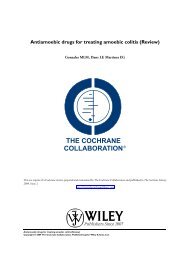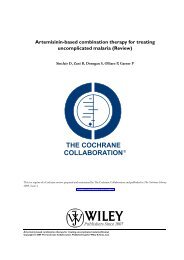Legislative smoking bans for reducing secondhand smoke exposure ...
Legislative smoking bans for reducing secondhand smoke exposure ...
Legislative smoking bans for reducing secondhand smoke exposure ...
You also want an ePaper? Increase the reach of your titles
YUMPU automatically turns print PDFs into web optimized ePapers that Google loves.
The duration of <strong>exposure</strong> <strong>for</strong> hospitality employees ranged from<br />
30-69 hours be<strong>for</strong>e the law was implemented and this was dramatically<br />
reduced afterwards, whether measured as percentage of<br />
those exposed (Eagan 2006, Jiménez-Ruiz 2008 or duration of<br />
<strong>exposure</strong> (Abrams 2006, Bondy 2009, Eisner 1998, Farrelly 2005,<br />
Goodman 2007, Hahn 2006, Menzies 2006). One quasi-experimental<br />
study (Bondy 2009) found a significant reduction (>95%)<br />
in total hours exposed to SHS (work and other) by non-<strong>smoking</strong><br />
employees in Toronto compared to the control. Whilst some<br />
venues had designated <strong>smoking</strong> areas in Toronto, only employees<br />
from venues with comprehensive <strong>bans</strong> were included in the study.<br />
Analysis 1.1<br />
Biomarkers of <strong>exposure</strong> to SHS<br />
Eighteen of these studies considered biomarker validation (Abrams<br />
2006; Akhtar 2007; Allwright 2005; Bondy 2009; CDC 2007;<br />
Ellingsen 2006; Farrelly 2005; Fernando 2007; Fernández 2009;<br />
Goodman 2007; Gotz 2008; Hahn 2006; Haw 2007; Menzies<br />
2006; Mulcahy 2005; Pearson 2009; Pell 2008; Semple 2007), the<br />
most frequent being cotinine measures, employed in 17 studies<br />
and saliva cotinine in 12 of those.<br />
Of 12 studies utilising saliva cotinine concentration as a measure<br />
of <strong>exposure</strong> to SHS, sizeable reductions in <strong>exposure</strong> ranging from<br />
39% to 89% were recorded. Five studies examined biomarkers as<br />
a measure of <strong>exposure</strong> in both <strong>smoke</strong>rs and non <strong>smoke</strong>rs, in three<br />
of which (Goodman 2007, Hahn 2006, Pell 2008), no significant<br />
change was seen in <strong>smoke</strong>rs’ concentrations and in two cases (<br />
Ellingsen 2006, Semple 2007) a reduction was seen in cotinine<br />
<strong>for</strong> those who <strong>smoke</strong>d, but less than in non <strong>smoke</strong>rs. See Analysis<br />
1.2<br />
Exposure to SHS in cars<br />
Five studies measured <strong>exposure</strong> to SHS in cars and found that it<br />
remained unchanged be<strong>for</strong>e and after the ban was implemented<br />
(Akhtar 2007; Fong 2006; Hahn 2006; Haw 2007; Pell 2008).<br />
One of these (Akhtar 2007) measured the percentage of children<br />
exposed and found both that it was low at baseline and unchanged<br />
at follow up. See Analysis 1.1.3.<br />
Exposure to SHS in homes<br />
Fifteen studies measured <strong>exposure</strong> to SHS in the home (Abrams<br />
2006; Akhtar 2007; Biener 2007; Brownson 1995; Fong 2006;<br />
Galán 2007; Gilpin 2002; Hahn 2006; Haw 2007; Hyland 2009;<br />
Jiménez-Ruiz 2008; Larsson 2008; Palmersheim 2006; Pell 2008;<br />
Waa 2006). In general there was no change after the implementation<br />
of the ban though some studies reported positive findings.<br />
Fong 2006 reported a significant reduction in homes allowing<br />
<strong>smoking</strong> and Gilpin 2002 indicated that the percentage of Cali<strong>for</strong>nian<br />
adults reporting <strong>smoke</strong>-free homes increased one year<br />
post ban. Similarly Waa 2006 reported reduced <strong>exposure</strong> in New<br />
Zealand. In two studies where home <strong>smoking</strong> was assessed, there<br />
was no change (Galán 2007 & Biener 2007). Galán 2007 showed<br />
a drop in <strong>smoking</strong> at work in compliance with the ban in Spain,<br />
but not at home. Similarly Biener 2007, in a Boston study showed<br />
no reduction in home <strong>smoking</strong> rates. See Analysis 1.1.4.<br />
In conclusion, in general studies report positive impact of <strong>bans</strong> on<br />
<strong>exposure</strong> to second-hand <strong>smoke</strong>, the most robust being cotinine<br />
validated studies, all of which showed the anticipated benefit. The<br />
high percentage of change reported in many studies reflect the<br />
absolute nature of the <strong>exposure</strong>, that is, either being protected or<br />
not from an environmental hazard - in this case passive tobacco.<br />
2 Measures of Active <strong>smoking</strong><br />
Full details of the results of this section are presented in Analysis<br />
2.1. Less than half of the studies considered active <strong>smoking</strong> and of<br />
those that did there was little methodological consistency. Three<br />
measures were considered - <strong>smoking</strong> prevalence rates, measures of<br />
tobacco consumption and reported <strong>smoking</strong> cessation. Twentythree<br />
of 50 studies contained some reference to active <strong>smoking</strong>,<br />
no study reported all three measures. Fifteen studies contained a<br />
measure of <strong>smoking</strong> prevalence; six of these considered <strong>smoking</strong><br />
prevalence only with no measure of consumption (Alcouffe 1997;<br />
Hahn 2008; Helakorpi 2008; Jiménez-Ruiz 2008; Lemstra 2008;<br />
Pell 2008); one considered both <strong>smoking</strong> prevalence in designated<br />
settings and cessation in<strong>for</strong>mation (Waa 2006); eight studies measured<br />
both <strong>smoking</strong> prevalence and consumption (Barone-Aldesi<br />
2006; Braverman 2008; Cesaroni 2008; Eisner 1998; Gallus 2007;<br />
Hahn 2006; Heloma 2003; Mullally 2009). Five studies assessed<br />
both tobacco consumption and cessation (Fong 2006; Galán 2007;<br />
Hyland 2009; Larsson 2008; Semple 2007), one considered tobacco<br />
consumption only (Fichtenberg 2000) and two considered<br />
cessation only (Biener 2007; Fowkes 2008).<br />
Smoking prevalence<br />
Whilst 15 studies included in<strong>for</strong>mation on <strong>smoking</strong> prevalence,<br />
it was reported primarily as a confounder or co-variable <strong>for</strong> interpretation<br />
of passive <strong>smoking</strong> <strong>exposure</strong> rather than an outcome<br />
measure in itself in five studies (Barone-Aldesi 2006; Eisner 1998;<br />
Hahn 2006; Jiménez-Ruiz 2008; Pell 2008). Barone-Aldesi 2006<br />
<strong>for</strong> instance estimated that the observed reduction in active <strong>smoking</strong><br />
after the ban in Italy could account <strong>for</strong> 0.7% of the decrease in<br />
acute myocardial infarction admissions. Eight remaining studies<br />
indicated a modest fall in <strong>smoking</strong>, either in relation to a reference<br />
group, or over time pre-post ban and two showed no change. See<br />
Analysis 2.1.<br />
An early French study of office workers in enclosed public places<br />
(Alcouffe 1997) failed to detect a change in prevalence at two-year<br />
follow up but indicated the ban was poorly observed. Mullally<br />
2009 showed that there was no significant change in <strong>smoking</strong><br />
prevalence of bar employees at one year follow up, though a drop<br />
<strong>Legislative</strong> <strong>smoking</strong> <strong>bans</strong> <strong>for</strong> <strong>reducing</strong> <strong>secondhand</strong> <strong>smoke</strong> <strong>exposure</strong>, <strong>smoking</strong> prevalence and tobacco consumption (Review)<br />
Copyright © 2010 The Cochrane Collaboration. Published by John Wiley & Sons, Ltd.<br />
8








